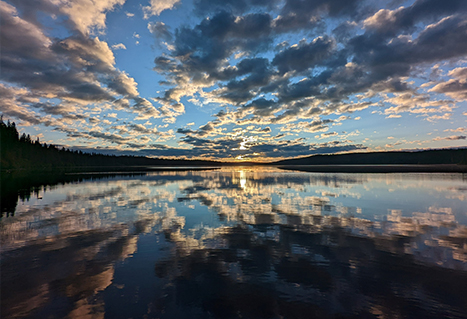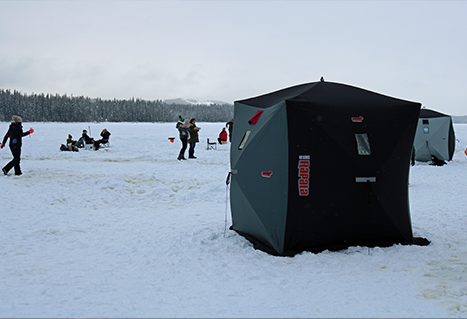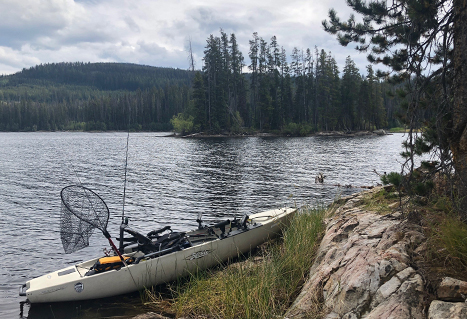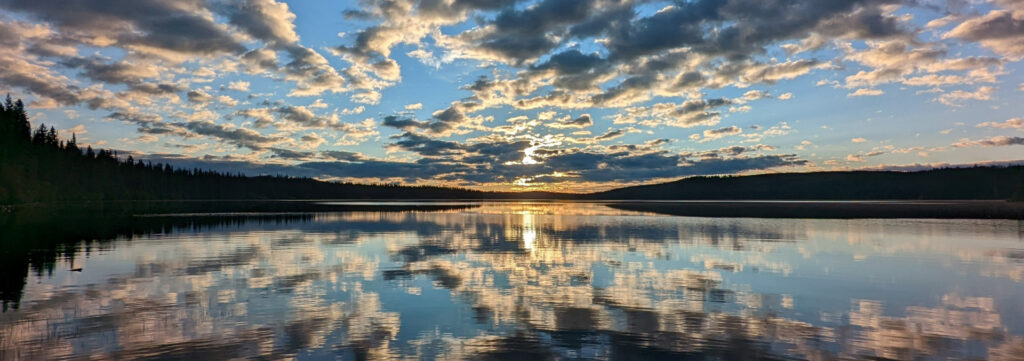The Okanagan region of British Columbia, although shy in stream and river fishing, more than makes up for that with its exciting and challenging fishing in stillwaters. Shore anglers, bellyboaters, fly, spin, and ice fishers have almost limitless lakes to drop a line. In the following article, we feature six that are close to Vernon, and provide detailed fishing tips to give you the best chance at multiple hook-ups!
1. Beaver/ Swalwell Lake
Location: 16 kilometres west of Winfield
Surface area: 259 hectares
Maximum depth: 30.5 metres
Mean depth: 9.7 metres
Elevation: 1,372 metres
Swalwell Lake, also known as Beaver Lake, is one the Okanagan’s most popular fishing destinations. Its natural beauty, high catch-rate of quality rainbow trout, and ease of access attract anglers of all ages.
Each year, the Freshwater Fisheries Society of BC stocks this large lake with 35,000 Pennask-strain rainbow trout. The many bays and islands found throughout the lake offer rainbow trout averaging 30 centimetres (and up to 50 centimetres) in length.
Trolling with wedding bands, Flatfish, or a willow leaf gang troll in the deeper areas of the lake and among the islands – while avoiding the shallows – yields good catches. Red, silver, and black are productive colours to use throughout the year. On overcast days, darker colours will attract more fish.
Fly fishermen troll black Doc Spratley, leech, and ’52 Buick patterns throughout the lake, concentrating their efforts around islands and rocky outcroppings. Manoeuvring your boat within the log debris and shallows while casting to rising fish with a Tom Thumb can reward you with an explosive strike. The best time to fish Swalwell Lake is from the end of May through to mid-July, and again in the fall. The heavy stocking and natural spawning provides great fly-fishing around the many islands and sheltered bays.
Ice-fishing is very popular, and there are many places on the lake that will be productive. Using a ¼-ounce jig tipped with Power Bait or maggots often results in good success. Don’t hesitate to jig a leech or shrimp fly-pattern. Concentrate your ice-fishing near the recreation site and around the islands.
FACILITIES: A 14-campsite recreation site has a good boat launch. There are pit toilets and picnic tables. Located at the southwestern end of the lake, the full-facility Beaver Lake Resort has a store, café, campground, boat launch, and wellness centre as well as boats, fishing equipment, and cabins for rent.
DIRECTIONS: Take Highway 97 to Winfield, and turn east onto Beaver Lake Road. Follow the marked signs for 16 kilometres to Swalwell Lake. The road is well-maintained.


2. Dee Lake Chain
Location: 25 kilometres northeast of Winfield
Surface area: 187.5 hectares (four lakes)
Maximum depth: eight to 13 metres
Mean depth: four metres
Elevation: 1,219 to 1,357 metres
Four interconnected lakes – with Dee Lake to the north and Crooked Lake to the south – make the Dee Lake Chain a great family fishing destination. Canoeing the chain is a good way to enjoy the day while viewing the area’s abundant wildlife.
With the stocking of 30,000 rainbow trout by the Freshwater Fisheries Society of BC and natural spawning in the chain, fishing success is high. The average length of trout in the Dee Lake chain is in the range of 30 to 35 centimetres, with the odd trout reaching 48 centimetres. At the northern end of the chain, Dee Lake – with the only fishing resort located on it – receives the highest fishing pressure.
Trolling with small spinners, Panther Martins, red wedding bands, and Flatfish in black, silver, or chrome works well. Since all the bays in the chain are shallow, trolling in the deeper areas will help avoid hang-ups on the bottom. Finding the lakes’ original channel in Island and Deer lakes will yield more fish during the warmer months of the year.
Small shallow bays and shoals at the northern end of Dee Lake produce well by anchoring the boat and fishing chironomids or dragonfly nymphs near the bottom. A slow troll just off the shallow areas with a ’52 Buick or blood leech works well in all the lakes.
Crooked Lake, at the southern end of the chain, is the most difficult lake to troll because of shallow areas and floating log debris throughout the lake. In the middle of the lake, floating grass islands provide some of the best fly-fishing, as trout will cruise around and below them to feed on the abundance of insects.
Early mornings and late evenings in June and July can provide the fly-flingers with incredible dry-fly fishing in the entire chain. Casting to rising trout with a Tom Thumb or Mikulak Sedge can be thrilling, especially when there are numerous obstacles like floating logs and lily pads.
Despite limited access for shore fishing throughout the chain, the dam at the southern end of Crooked Lake offers the best opportunity. You can also venture out and explore the fine fishing in numerous other nearby lakes.
FACILITIES: Dee Lake Wilderness Resort is located on the northern end of the chain. The resort has a small store and offers cabins, cottages, campsites, kayaks, and boats for rent. Island Lake has a 34-vehicle recreation campsite with pit toilets and a good boat launch.
DIRECTIONS: Via Kelowna, turn right (east) in Winfield at Beaver Lake Road. Follow the road for 16 kilometres to Beaver Lake. Turn left (north) and travel eight kilometres to Island Lake and two kilometres more to Dee Lake.

3. Echo Lake
Location: 50 kilometres east of Vernon
Surface area: 70 hectares
Maximum depth: 50 metres
Mean depth: six metres
Elevation: 840 metres
Located just outside of Lumby, Echo is one of the Okanagan’s most picturesque lakes. A popular regional recreation destination, it lies within the boundaries of Echo Lake Provincial Park, and gets its name from the reverberations created from its setting amid tall mountains.
The clear, turquoise-coloured waters offer excellent fishing for kokanee and large rainbow and lake trout. The park is strictly managed for day-use, except at the resort. Trails along the shoreline provide numerous locations for shore fishing.
Echo Lake has moderate to heavy angling pressure throughout the year. The Freshwater Fisheries Society of BC stocks 15,000 rainbow trout, including Pennask and Blackwater strains. The majority of the released fish are triploids or sterile to increase the number of larger, brighter fish available to catch. Larger rainbow and lake trout are primarily caught by deep-trolling big spoons and plugs in green, pink, and black using a downrigger or lead line. Gang trolls with a wedding band will entice both the rainbows and kokanee.
Early in the day or at dawn the lake is generally calm, and fish can be seen breaking the surface. While trolling is the most popular method of fishing, fly fishers can do well, notably over the shoals on the northern side and western end of the lake. The lake has a healthy population of gammarus shrimp, contributing to the large size and superb condition of the fish in the lake. In June and July, use full-sinking fly lines to slowly strip-retrieve or troll a dragonfly nymph, shrimp, or blood leech pattern near drop-offs and weed beds. With patience, fishing a chironomid pattern under a strike indicator on the shoals is productive in early summer and autumn.
Ice-fishing on Echo lake is a popular family activity. Access to the lake is maintained throughout the winter. Popular tactics include suspending a hook baited with cooked shrimp, or using a jig tipped with a maggot.
FACILITIES: Echo Lake Fishing Resort is located on the northern shore of the lake within Echo Lake Provincial Park. It provides boat rentals, a boat launch, cabins, campsites, swimming, a playground, and a store.
DIRECTIONS: Located 50 kilometres east of Vernon, take Highway 6 to Lumby. Turn right onto Creighton Valley Road, and follow road for 22 kilometres to the lake.
4. Kalamalka Lake
Location: Between Oyama and Vernon
Surface area: 3,267 hectares
Maximum depth: 1,48 metres
Mean depth: 58.5 metres
Elevation: 391 metres
Kalamalka is commonly known as “The Lake of Many Colours.” When its waters warm in the summer, dissolved calcium carbonate (or limestone) forms crystals that reflect sunlight to create the lake’s exquisite blue-green hues.
A large lake, Kalamalka is situated between Vernon and south to Oyama along Highway 97. Busy with water-skiers and boaters in the summer, anglers have their best luck from fall to spring. At the present time, the Freshwater Fisheries Society of BC is not actively stocking this lake; it was last stocked in 1978 with 30,000 lake trout. Northern pike minnow and whitefish are also present in this lake.
The lake boasts big lake trout that weigh nearly 11 kilograms, and rainbow trout weighing up to 6.5 kilograms. Lake trout are mainly caught by trolling lures deeply (at 25- to 50-metre depths) with a downrigger. Big lures – like chrome-coloured Apex Hot Spot Trolling Lures, William’s Wablers, and various colours of Lyman plugs – can produce one of the lunkers. Although rainbow trout are not as abundant as the other species, they are known to attain weights of up to five kilograms, but the average weights range from one to two kilograms. While smaller rainbows will take the same lures as kokanee, larger ones typically strike bigger lures.
Preferred regions of the lake for kokanee are near Rattle Snake Point and Cousins Bay, or near the rock walls on the eastern side. Mepps and Blue Fox spinners in red or chartreuse work well in the 10- to 15-metre depths. Anglers can increase their odds by tipping the lures’ hooks with Power Bait or maggots. Vertical jigging with small jigs in the same colours also works well in these locations. Although kokanee have an average length of 30 centimetres, they have been caught weighing up to two kilograms. There is a daily quota of two kokanee; various locations on the lake have speed restrictions or “no vessels” signs and buoys.
Shoreline fishing is possible, especially along the western side of the lake where the railway tracks are (but use caution: the railway system is active). There is good accessibility to the lake at Kekuli Bay Provincial Park, and also at Kaloya Regional Park on the southern end (both are wheelchair accessible). The use of bobbers with worms or Power Bait can be used for trout, kokanee, and carp. Look for deeper water or drop-offs.
Although not as popular on Kalamalka Lake, fly-fishing can be productive from spring to early fall. The sheltered bays, concentrating on the drop-offs, can yield the odd rainbow trout and kokanee. Use streamer patterns or a beadhead Woolly Bugger. In the summer, grasshopper patterns near the old pilings on the southwestern shoreline can also be productive for rainbows. Fly-fishing the shallow water at each end of the lake with small beaded Hare’s Ear or Pheasant Tail Nymph patterns can entice some of the big carp in this lake to strike.
FACILITIES: Kekuli Bay Provincial Park offers a concrete double-lane boat launch, potable water, showers, pit toilets, camping, and a day-use area with parking. Near Vernon, there are two boat launches: one at 12908 Kinloch Drive off Coldstream Creek Road, and the other at 8484 Kalavista Drive. There are private campgrounds located at both ends of the lake.
DIRECTIONS: Along Highway 97 between Oyama and Vernon. Kekuli Bay Provincial Park is located 11 kilometres south of Vernon.
5. Oyama Lake
Location: 15 kilometres from Oyama
Surface area: 261 hectares
Maximum depth: 24 metres
Mean depth: 6.7 metres
Elevation: 1,341 metres
Situated between Kelowna and Vernon, Oyama Lake is a beautiful high-elevation lake with an irregular shoreline and many islands. Since it is a water supply for local communities, water levels can fluctuate significantly. The Freshwater Fisheries society of BC stocks the lake annually with 15,000 diploid rainbow trout.
The wind can pick up on this larger lake, but its 27 islands – dotted throughout the northern and eastern portions – offer lots of protection. Many sunken islands, weed beds, and an abundance of feed provide ideal fishing conditions throughout the fishing season. During the heat of summer, fish will go down into deeper water, especially during the day. The rest of the year, fish are feeding in the shallows around the islands and weed beds.
Late spring and early summer are most productive for fishing Oyama Lake. The shoal area at the northeastern end of the lake is a good area to work chironomid, damsel fly nymph, and small dragonfly nymph patterns. In the heat of summer, trolling slowly using full-sinking lines with a leech or ’52 Buick pattern works well. The many sunken islands and shoals create the perfect environment for sedges during the summer months. Casting to rising fish with a Tom Thumb or Mikulak Sedge pattern can be rewarding and very productive well into the late evening. As the water cools off in the fall, switch back to fishing the shallows with dragonfly nymph, leech, and water boatman patterns.
For the anglers who don’t fly-fish, Oyama Lake is a beautiful lake to troll around. Small spinners and Flatfish in black, silver, or green work the best. Be careful with the shallow areas and sunken islands when trolling deeply. For a change in scenery, take a tour into Streak Lake through the channel at the eastern end of the lake. The channel is fairly narrow, although still wide enough for a canoe or aluminum boat, and is populated with an abundance of waterfowl. Small bays along the channel provide opportunities to cast a dry fly to smaller rainbows. Take time out of your fishing day to have a shore lunch on one of the many islands of this jewel in the Okanagan.
FACILITIES: Oyama Lake has a medium-sized recreation site with five sites, pit toilets, and a boat launch on the northern side of the lake. Oyama Lake Eco Lodge is near the recreation site; it has cabins, boat rentals, and a store.
DIRECTIONS: From Kelowna, travel north along Highway 97 towards Vernon to the turnoff to the town of Oyama. Turn right (east) and proceed through the town and onto Oyama Lake Road. Follow the road for 13 kilometres. There will be a road on your right, with signs pointing to Oyama Lake Resort. The lake is another two kilometres down the road.

6. Wood Lake
Location: Between Winfield and Oyama
Surface area: 930 hectares
Maximum depth: 34 metres
Mean depth: 16 metres
Elevation: 394 metres
Easy-to-access Wood Lake is located on Highway 97 between Vernon and Kelowna, just south of Kalamalka Lake. Known for its kokanee fishing and many water sports, Wood Lake is a favourite with both locals and those passing through who just want to wet a line. Early ice-off provides great fishing for both gear- and fly-anglers. As special fishing regulations are in place throughout the year, be sure to refer to the current regulations synopsis. No ice-fishing is allowed.
During the peak summer months, Wood Lake can be very busy with water-skiers, leisure boaters, and swimmers around the beaches. Head out onto the lake in the early morning or during dusk hours to avoid the high traffic on the water.
Trolling slowly at various depths using light gear (like a willow leaf gang troll and wedding band, chartreuse or red spinners, or small Lyman plugs) can entice both kokanee and trout. There are also populations of perch, chub, carp, and pike minnow. The more productive areas to troll for kokanee and rainbow trout are along the western shore and southeastern corner of the lake. Other good places to fish are close to rocky outcroppings near the boat launch. One can park off Highway 97 at a few pullouts to fish from the rocky shore.
Fly fisherman can target these same areas. Try trolling with a fast-sinking line and various colours of Doc Spratley or weighted leech patterns. Other areas worth considering are along the eastern shoreline, or around midway across from the western boat launch. During May and June, look for ant or mayfly hatches, especially near eastside creek mouths.
This lake is not currently stocked by the Freshwater Fisheries Society of BC.
FACILITIES: A public beach is located at the northern end of the lake where one can swim safely, away from motorized boats. There are two boat launches on Wood Lake. The one located midway along Highway 97 can handle boats with a trailer, but be careful of the rocky shoreline near the launch. In the northeastern corner, the second is a rough cartop boat launch. You can find picnic tables along Highway 97, as well as Oyama Lake Road, where you can access the shoreline. Reiswig Regional Park also offers picnic tables, and a beach with some shelter from south winds.
DIRECTIONS: Wood Lake is located between Oyama and Winfield on Highway 97.
We’ve covered six lakes with great fishing near Vernon, yet there are hundreds more in the Okanagan you can discover. Visit the Where to Fish map to see stocked lakes, and use filters to find spots with boat launches, campsites, and docks. Remember to bring along your freshwater fishing licence (all anglers 16 years and older require a licence in B.C.), and check the freshwater fishing regulations before heading to any lake.
Author: Staff, Freshwater Fisheries Society of BC
Banner image: Brandon Lamb.
